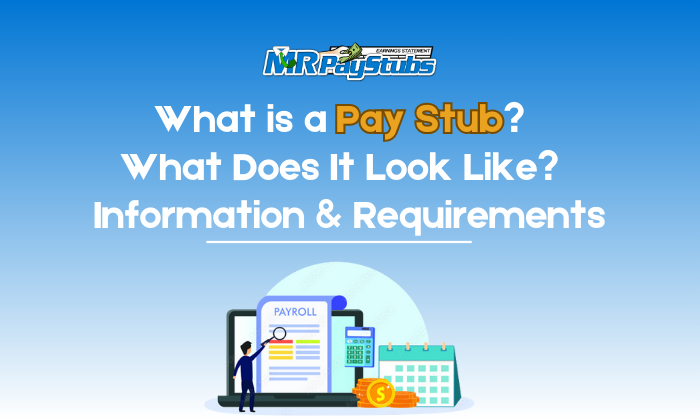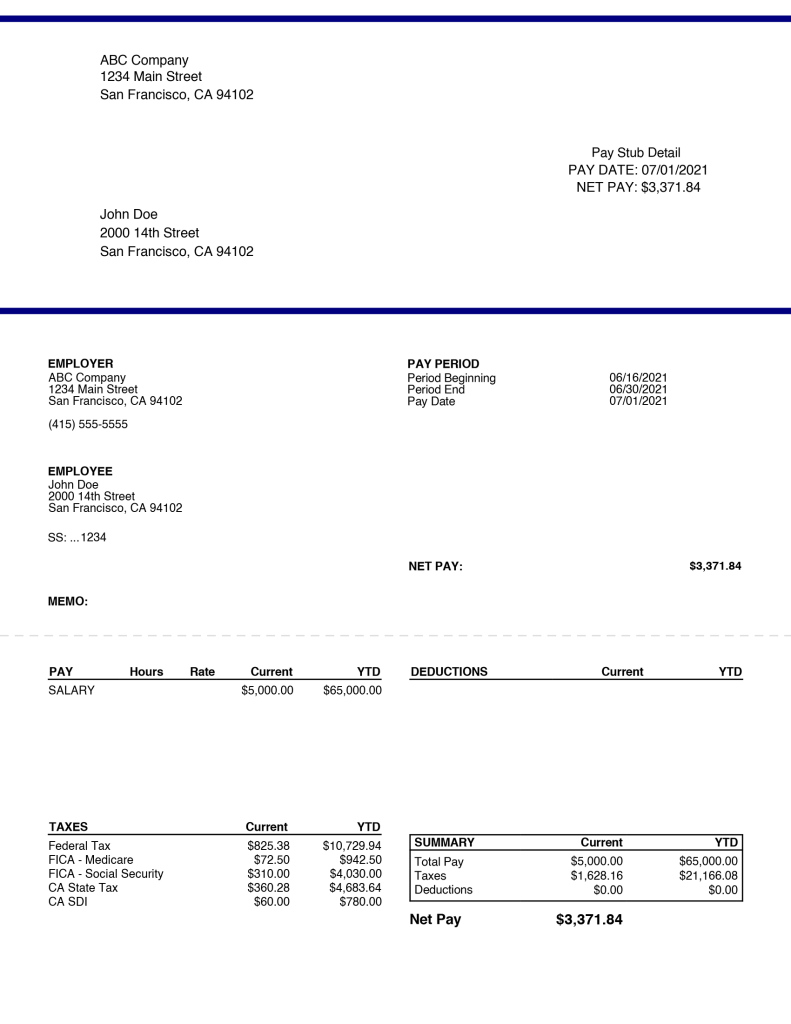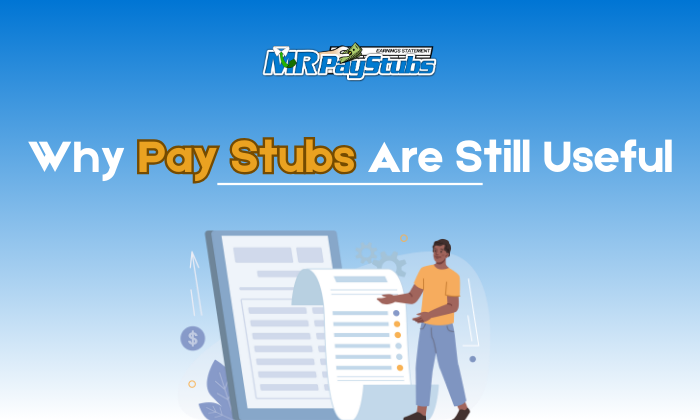
Table of Contents
What is a Pay Stub?
A pay stub is a document that states what an employee has earned during a pay period, what deductions have been withheld from the paycheck, as well as the net amount which the employee received. Pay Stubs are often used as proof of income.
If you’re of a certain age, you may remember waiting in line to deposit your paycheck on Fridays during your lunch hour. Millennials, on the other hand, are so used to the convenience of direct deposit that they can’t imagine payday any other way. In 2018, around 93 percent of U.S. workers got their pay electronically.
Direct deposit is a godsend, but there’s one downside: Traditional paper checks had a pay stub attached. An employee who wondered what took such a big bite out of his pay could just read it and weep.
Is there an advantage to physical pay stubs even in the digital age?

Pay Stubs Requirements
That depends on where you operate your business. Surprisingly, the feds don’t care if you furnish them or not and leave the decision up to individual states.
Twenty-six states require that employees can at least access their pay records. Eleven require handwritten or printed pay stubs. Some states have no rules about stubs at all.
Either way, under the Fair Labor Standards Act, you still have to juggle a number of records — 14 at a minimum — for each employee on your payroll:
- Full name and social security number.
- Address.
- Birth date if younger than 19.
- Sex and occupation.
- Time and day of week when employee’s workweek begins.
- Hours worked each day.
- Total hours worked each workweek.
- Basis, such as hourly or weekly, on which employee’s wages are paid.
- Regular hourly pay rate.
- Total daily or weekly straight-time earnings.
- Total overtime earnings for the workweek.
- All additions to or deductions from the employee’s wages.
- Total wages paid each pay period.
- Date of payment and the pay period covered by the payment.
The feds aren’t picky about the recording method you use, but they’re real sticklers for accuracy. The scariest record-keeping requirement is No. 12, “All additions to or deductions from the employee’s wages.” In addition to tracking how much people earn and how many hours they work, you have to report every little thing that affects their gross pay.
Rule No. 12 is the one that makes manually generated pay stubs the stuff of nightmares for business owners.
What do Pay Stubs Look Like?
The following is a typically pay stub template:

For employees who don’t know how to read them, paycheck stubs are terrifying documents filled with boxes and numbers and codes and acronyms.
You would do some workers a great service by talking them through the sections to explain where a portion of their money goes. If you haven’t used pay stubs in a while, they’re worth brushing up on.
Here’s a breakdown of the most typical information on a stub:
Gross pay
This is the total amount of money earned in the pay period before taxes or other deductions. On a biweekly payroll stub, for example, it would show $1923.08 in gross pay for an employee earning $50,000 per year. For hourly workers, gross pay is the number of hours worked multiplied by the hourly rate.
Pay stubs should itemize regular pay, overtime pay, bonuses, or wages earned doing a job that pays a different rate. If a server in a restaurant subbed in as a hostess one night, for instance, she should be able to see her hours and rate of pay for just that shift.
It’s worth mentioning that restaurant check stubs often have line items, such as a meal allowance, that other businesses do not. One of the trickiest to explain is the tip credit. It ensures that tipped employees earn at least minimum wage between their hourly rate, which is often quite low, and their tips. On pay stubs, the tip credit causes a lot of confusion.
Taxes
Predictably, the taxes section is the most complex. There are separate boxes for federal taxes and state or local taxes if they apply. Finally, there’s FICA. That one usually stumps people who are new to the workforce, but it’s easily explained.
FICA stands for Federal Insurance Contributions Act. The contributions are to Social Security and Medicare, and they’re listed separately on pay stubs. For regular employees, 6.2 percent goes to Social Security while 1.45 percent goes to Medicare.
Other deductions or additions
If you’ve put certain programs in place, you’ll have even more explaining to do. There might be deductions for health insurance premiums or a retirement savings plan.
If you’re generous with fringe benefits, like child care expenses, gym memberships or transportation perks, be sure they’re reported somewhere in the breakdown of gross income. Most are taxable, and employees shouldn’t be unpleasantly surprised by that at tax time.
The pay stub should also reflect garnished tax or child support payments.
Net pay
This is what the employee takes home when all deductions and additions are said and done.
Each category on the pay stub should have details for the current pay period and running totals of year-to-date earnings, taxes, deductions, additions and net pay. Ideally, the last stub of the tax year perfectly matches the W-2.
Pay Stub Abbreviations
Payroll companies abbreviate the information that is printed on your pay stub to reduce it and make it easier for them to fit a lot of information on a single sheet of paper. If you come a cross an abbreviation you don’t understand check out our article on various pay stub abbreviations.

How Long to Keep Pay Stubs
Pay stubs are an important proof of income document that needs to be kept in your financial records. Therefore, knowing how long to keep your pay stubs depends on your exact situation. However, the general rule of thumb is to keep them for at least 3 years.

Why Pay Stubs Are Still Useful
Pay stubs come in handy when workers try to rent apartments, buy homes, set up utilities or get car loans. Tracking pay stubs helps workers better manage their money and save for the future. If you ever have to lay off employees, they might need recent proof of pay to file for unemployment insurance.
Pay stubs have benefits for business owners too. Nobody’s perfect. You could forget to put in a promised pay raise. You could incorrectly enter someone’s withholding.
With any luck, the employee will catch the error on the pay stub and bring it to your attention; the mistake won’t repeat through several pay cycles. You don’t need the headache of correcting weeks-old errors.
In short, old-fashioned pay stubs are still nice to have.
The Burden on Business Owners
Manually reporting and tracking employee pay can make filing your own taxes look like child’s play. Even careful business owners can’t rule out human error, and human error could land you in a world of hurt.
Every day, employers pay steep fines for making honest mistakes. They misclassify regular workers as independent contractors. They don’t process court-ordered garnishments correctly. They accidentally deduct a uniform cost from the wrong employee’s pay. They follow federal regulations to the letter but overlook obscure state rules.
Again, employees can check pay stubs for errors. Stubs create a checks-and-balances system that protects both the worker and the business owner. Mistakes can be corrected before anybody gets into hot water with the authorities.
Is There an Easier Way?
Yes, fortunately, there is. You needn’t crunch and recrunch numbers to generate accurate pay stubs. An automated pay stub generator for each payroll run dots the i’s and crosses the t’s for you. Enlisting a quality payroll service isn’t a bad idea either.
That will free up your time for what matters most: managing, growing and enjoying your business.